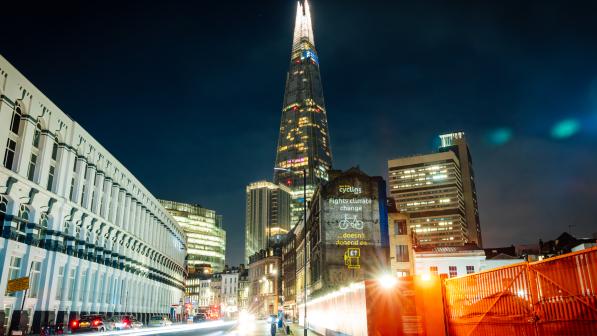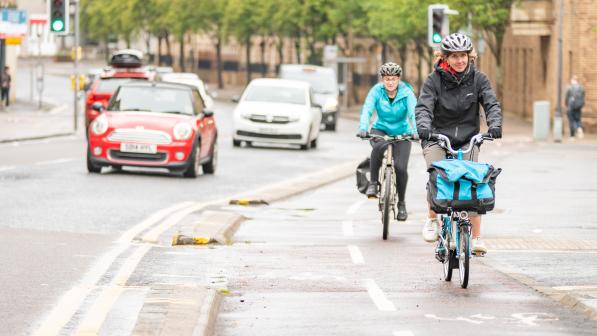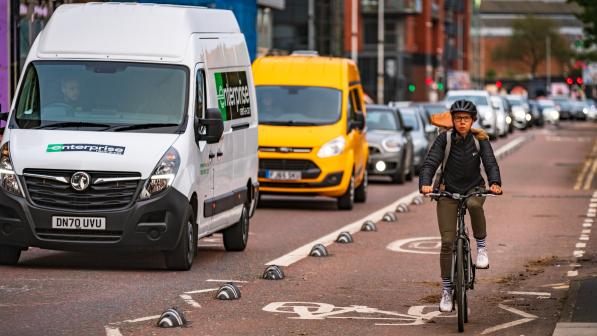Less traffic, more cycling

The noise, fumes, inconvenience and intimidation caused by too much traffic are only conspicuous when they’re absent. They’ve become part of the urban background – except in towns and cities that have decided to do things differently.
This summer I was in Ljubljana, the capital of Slovenia. It’s an amazing city. I was there on an Interrailing trip through Europe with my family. A huge area of the old city is pedestrianised, and it was being enjoyed by thousands of people taking in the sights, buying from market stalls and food vendors, and relaxing in on-street café seating.
It felt safe and welcoming enough to allow our teenage boys to go off exploring for themselves and sample the local patisserie.
We waved farewell to the traffic-free spaces of Ljubljana and jumped on another train headed for Trieste on Italy’s Adriatic coast, arriving on a hot and sticky afternoon. Trieste is only 60 miles from Ljubljana. It felt a world away, with noisy, bustling streets, narrow pavements, traffic fumes, and cars and mopeds speeding by or clogging the streets. The place felt overwhelmed by vehicles.
I was aware that I was experiencing each city and town we visited as a first-time tourist, seeing only a snapshot of life and forming first impressions. For someone visiting my city of Glasgow for the first time, negotiating the traffic weaving its way through the city centre may also leave a bad taste in the mouth – literally – even though I’m used to it.
The increase in traffic is a good example of the slow creep of change over decades that we don’t realise, get accustomed to and often put up with in our day-to-day lives – even if we are stuck in a traffic jam. In reality, though, the change has been huge since the middle of the last century, with the number of motor vehicles in the UK quadrupling to more than 33 million and the number of miles driven yearly in Great Britain increasing tenfold.

Pedal for the planet
As a society we have to do something to halt this growth in traffic and car use, not least for the health of our planet. Transport is the largest contributor of climate emissions of any sector of the UK’s economy, and cars are the biggest source from transport. But the government predicts that the numbers of cars on the roads in England and Wales will increase by as much as 54% by 2060.
Even now, without that future growth in traffic, we have serious congestion blighting many of our towns and cities. It makes our communities dirty, noisy, busy and dangerous, robs children of the freedom to ride to school, and traps some older people in their homes.
Something has to change but are any of political parties brave enough to tackle this thorny issue and make the places we live in people friendly rather than car centric?
A survey by Sustrans revealed that 62% of people agree it would help people cycle more if there was less motor vehicle traffic on the streets. So, if we did make neighbourhoods more peaceful and roads quieter, would more people really cycle?
This did happen during the first Covid lockdown, when people only ventured out for daily exercise or essentials. There was a huge increase in cycling at that time and people felt safer on the roads.
It worked in Ljubljana, too. After a 52% increase in car use between 2002 and 2012, politicians set out on a radical plan to limit motor vehicles and instead give greater priority to pedestrians, cyclists and public transport. Numerous measures were introduced, including pedestrianisation across more than 10 hectares of the city centre, which I enjoyed so much on my holiday. It’s no surprise that 13% of journeys in the city are now cycled – compared to just under 2% nationally in the UK.

Put people first
There’s no reason why these benefits can’t be experienced by people in towns, cities, and villages across the UK. Our politicians should follow the lead of their European counterparts by transforming places for people, and being bold and steadfast in their decisions. It also takes organisations like Cycling UK to speak up and explain why the country would benefit from less traffic and how quieter roads and peaceful places designed for people, not cars, are key to enabling more people to cycle and feel the benefits.
Cycling UK’s mission is to enable millions more to cycle, but we know that it’s not enough just to call for more dedicated, safe cycling infrastructure. Not every road can accommodate a cycle lane and not every roundabout in the country is going to be made safe for cycling within the next few years. To enable people to cycle and for governments to meet climate targets, we have to cut the number of journeys taken by car – especially those shorter everyday local trips. Did you know that 60% of all car journeys in England are under five miles, a distance that many people could cycle?
It’s a huge challenge but Ljubljana – together with many other cities – shows that it’s possible in a relatively short time. Paris is limiting cars crossing the city, and pedestrianising parts of the city centre ahead of the Olympics.
Barcelona’s ‘superblocks’ initiative aims to put people before cars. Ghent in Belgium introduced a city ‘circulation plan’ in 2017, which dramatically cut car travel in the centre and consequently also decreased collisions, increased bus use, boosted cycling from 22% of journeys to 37%, and created a more peaceful, people-centred place to live.
The lesson from all of these pioneering places is that as well as cutting car use, they have provided citizens with real choice for everyday journeys. In the UK we need better, fairer and more affordable transport systems, where people have more choice in how they travel and aren’t forced to rely on a car for day-to-day journeys.

Not so fast, drivers
Policies and measures to make places people friendly and to deprioritise and calm traffic are cropping up around the UK. They are popular – despite what some newspapers say. For example, in Scotland 20mph zones were created in more than 90 villages and towns across the Borders Council area in 2020. Data shows they’ve been successful in reducing traffic speeds.
Ross Hall from Galashiels in the Borders frequently rides a bike and is a committee member at the Gala Men’s Shed, which loans e-bikes to people in the area. He believes that the 20mph limits have potentially improved safety.
He said: “E-bikes are ideal in Galashiels as it is situated in a valley and every journey has an uphill section at some point. It is important to respect other road users, and the extra e-power helps riders to keep up with vehicles travelling at 20mph. This boost makes people feel safer and confident to cycle for local journeys rather than having to use a car.”
Scott Runciman, who runs Cycling UK’s Rural Connections projects in the Borders, echoes Ross. “I’ve noticed a real change in attitudes in the Borders since I grew up here. A lot of people are rediscovering cycling and wanting to take the car less. Slower traffic makes my role easier but most importantly it makes a real difference to people’s lives and to the local area.”

The switch to cycling
High traffic levels and a lack of quality cycling infrastructure are not the only barriers to cycling; many people can’t ride because they lack confidence or skills, or they don’t have access to a bike. Cycling UK’s projects aim to address these challenges head on and get people cycling.
What’s more, many of our projects are explicitly designed to help people to cycle as an alternative to jumping in the car for short local journeys. We want people to be free to live healthy lifestyles and cut their carbon footprint as much as they feel able.
Erika Ikeda from West Yorkshire used to rely on a mix of car and public transport to get around but was looking for other transport options. She went along to a Cycling UK Big Bike Revival event, and since then has been using her bike to commute along the canal.
She returned to the project, run in association with the Margaret Carey Foundation, to get her bike serviced and learn how to maintain it herself. “It’s important for my confidence that I know my bike is safe and working well,” she said.
“Now I will try and ride further. I feel more comfortable and confident to go on the road, but this has always been a bit of a worry due to traffic and not feeling confident.”
Sheffield stonemason Steve Roche – whom we mentioned last issue – began cycling to work through Cycling UK’s Making cycling e-asier project. Fed up with spending his morning commute stuck in traffic at rush hour, he signed up for a free e-cycle loan. In just a month, he was pleased to discover that he lost over half a stone and also saved £25 per week on fuel.
“My commute is perfectly doable on an e-bike,” he said. “It now seems like madness that I was driving around, running an engine and getting stuck in traffic every day. Sheffield is very hilly, so I do need the extra assistance to be able to carry my tools and materials, and my job is quite physical, so it means that I don’t arrive at work absolutely knackered. I can’t believe that more trades people are not doing it.”
The vast majority of people can be part of the solution by cycling more or taking public transport where available. We can also benefit from measures designed to make cycling easier than using a car.
There’s a strong case for change, and cycling can be at the heart of it. Enabling more people to cycle is one of the positive outcomes of policies designed to reduce car use, and it is also one of the ways to have fewer cars on the road.


